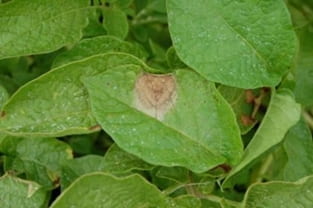Kate Everts, Vegetable Pathologist, University of Delaware and University of Maryland; keverts@umd.edu
Late blight has been confirmed in a greenhouse in Garrett County, the far western county in Maryland. Delaware potatoes and tomatoes are not at imminent risk at this time, but growers should use good management practices for late blight.
During the field season plants should be inspected weekly. A preventative fungicide program should begin when plants are 6” tall. Chlorothalonil, Dithane or Polyram are good fungicides to use to protect the crop if late blight is not known to be present in the area. When the threat of disease is high, or if the disease is present in an area, fungicides that target oomycetes diseases (late blight is an oomycete disease) should be used. There are good fungicides available for late blight including Curzate, Ranman, Gavel, and Revus. A more comprehensive list is available in the Mid-Atlantic Commercial Vegetable Production Recommendations. Additional products, Orondis Opti and Orondis Ultra, were registered after the Vegetable Production Recommendations were printed.
The strain that is present in Maryland is US23. US23 has also been the most common strain in the Mid-Atlantic for the past several years. The characteristics of US23 are that is causes disease on both potato and tomato and it is sensitive to mefenoxam (although resistant strains could develop in the future). An excellent source of information about this pathogen is found at the website dedicated to late blight (http://www.usablight.org/).
An alternative to applying your sprays on a calendar schedule is to follow the late blight forecasts from Extension, or to enter your potato crop information into the Cornell DSS at http://www.usablight.org/. The Cornell DSS is being used to generate late blight forecasts for eight locations across Maryland based on the programs Blightcast and Simcast. Interested potato growers in Maryland and Delaware can receive regular Potato Late Forecasts, which are provided by both states. To receive these reports in Delaware contact Nathan M. Kleczewski Ph.D., UD Extension Specialist-Plant Pathology at 302-831-6674, and in Maryland contact Kate Everts at 410-742-8788 or keverts@umd.edu.
Late blight management in organic production is more difficult than in conventional production. An excellent resource for organic growers is an article is from the extension web site eOrganic, http://www.extension.org/pages/18351/organicmanagement-of-late-blight-of-potato-and-tomato-with-copper-products. The article is very comprehensive, but a few of the highlights are:
- In field trials of organically managed crops, copper products have provided the best control of late blight, although preliminary lab studies indicate some other products may also be effective.
- Be Proactive. Preventive treatments are necessary to manage late blight on an organic farm. It is always better to apply the products before late blight onset than to wait to treat after late blight is present.
- If late blight gets out of hand, the potato or tomato crop should be destroyed to limit risk for other fields on your farm as well as fields on adjacent farms. This is a community disease and management by all growers is necessary to reduce damage within a region.
- When deciding if it is worthwhile to try to manage the disease (vs. destroying the crop), consider how close the crop is to harvest. One study estimated that applications of copper treatments for late blight will prolong potato plant productivity for two to four weeks. Remember also that the length of time a crop will survive is dependent on the weather; cool temperatures and lots of rain will make the disease progress very rapidly.
Photos of symptoms of late blight on potato tuber and leaves are courtesy of Dr. Amanda Gevens, Univ. of Wisconsin
Note brown-rust colored firm discolored tuber tissue.
A late blight lesion on potato leaf. Lesions appear brown and papery when weather turns dry or after fungicide use.
Underside of leaf showing late blight pathogen producing spores.



